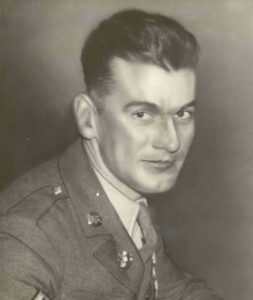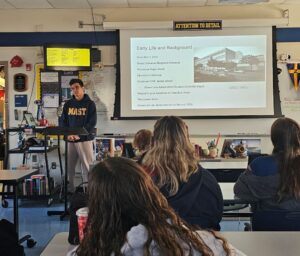It is a portion of American history that should be taught in every high school in the United States. It is taught to every Junior at MAST, the Marine Academy of Science and Technology over a two-week period every year and was created and designed by the Senior Naval Science Instructor at MAST’s NJROTC program, Commander Tracie Smith-Yeoman, USN (Ret).
The class is on the Medal of Honor and Smith-Yeoman involves the class in individual presentations and lively discussions about the history of the highest award for a military person and the men and woman who have been its recipients since it was first presented by President Abraham Lincoln for valor in the Civil War.
Shortly after the start of each school year since she started teaching at MAST 12 years ago, Smith-Yeoman gives a presentation and lecture on the Medal of Honor to each of the junior year students, explaining its importance and responding to student questions about the Medal and its recipients. Prior to the class, most students were not aware of any of the significance of the Medal, she said, but all are interested in learning more about it and the services of those who received it.
“The exception is students who graduated from Thorne Middle School in Middletown,” Smith-Yeoman said.

“They not only know about the Medal of Honor and one recipient, Corporal Horace “Buddy” Thorne; they’re eager to tell me that their school is named in his honor and is the resting place for his Medal of Honor.
Most also tell her, she said, how Corporal Thorne’s sister still comes to speak to classes to speak on not only her brother the importance of all military and the sacrifices all make in defense of the country.
Thorne students know about Wreaths Across America and the fact MAST cadets have been to the school to participate in ceremonies surrounding that annual event when it includes Thorne School on its pre-holiday route.
After the first class on the history of the Medal of Honor and its recipients, Smith-Yeoman assigns students to read on other recipients on their own. Each student then selects one medal recipient he or she would like to research; then, over a period of two weeks, each student presents an oral and power point presentation to the class. Their presentation must include citing their sources of information and why they selected that particular recipient, the recipient‘s background, in which war he or she was cited for bravery and what actions merited him or her the Medal of Honor.

Students must also be prepared to answer questions from the class at the conclusion of their presentation.
Over the two-week period, three or four students in each class give their presentation on assigned school days until all approximately 70 students have completed their presentations. No two students in the same class period are permitted to present on the same military honoree to ensure more Medal recipients are recognized.

On a recent day when three students were scheduled to give their presentations in an 8 am class at MAST, they did it flawlessly, with accurate information, and without reading from notes.
Each set up their own power point presentations and made reference to it during their 15-to-20-minute presentation. They also all cited various points of information in the power point. Each highlighted not only the specific deed for which the service member was honored, but also his background prior to military service, his life afterwards if he came home from war and where and how he has been honored since the presentation of the Medal to either him or his family. Students also identified, when known, where the Medal of Honor is today.

With time left in the class period, Smith-Yeoman asked if any student who had presented his or her story at an early session wanted to give it again for a class visitor. One-third of the class raised their hands, eager to speak on the Medal of Honor recipient that was particularly important to him or her, an obvious indication of the student interest in the program, their pride in their own knowledge and their eagerness to share it with others.
According to Smith-Yeoman, many students over the years picked the Medal of Honor projects as their favorite part of the Naval Science III class. The students start with a very limited knowledge of the Medal (i.e., they know it’s the highest military award, it’s a “big deal”, it’s usually given by the President), but they are always drawn in by the stories of the 3518 men and 1 woman, most of whom came from humble backgrounds, who, when faced with a life or death decision, made the choice to possibly sacrifice their own lives to save others. The students realize that we all have the power to go above and beyond in a difficult situation, “and I believe that gives them hope that they can make the right decisions in difficult situations they may face in their own lives.”


